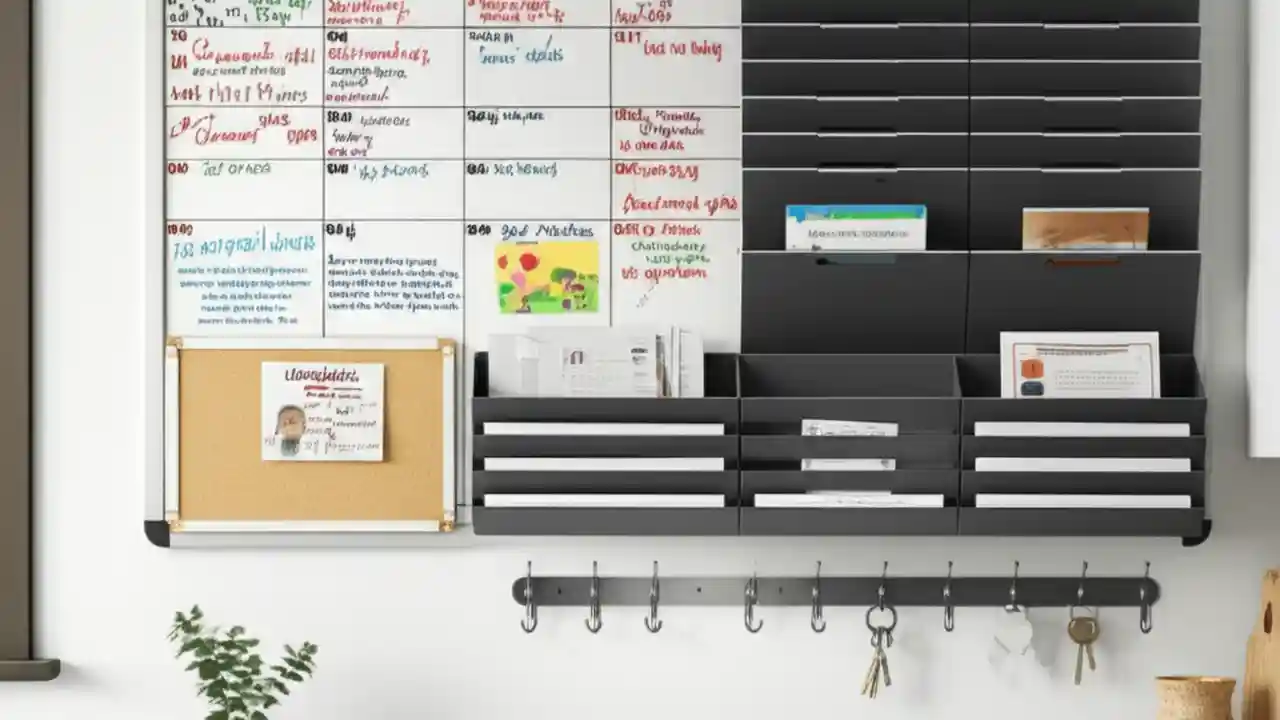The absolute best healthy and easy homemade soup comes down to a simple, foolproof formula: start with a flavorful broth, add a lean protein, and pack it with a variety of colorful vegetables. That’s it. With this basic blueprint, you can create countless delicious, nourishing soups in under 30 minutes, right in your own kitchen.
As someone who has spent two decades crafting recipes and exploring the nuances of nutrition, I’ve learned that a great soup doesn’t require hours of simmering or complicated ingredients. It’s about smart techniques and understanding how flavors work together. Forget the high-sodium canned stuff; a world of vibrant, satisfying soup is more accessible than you think.
In this definitive guide, we’ll go beyond just listing ingredients. We’ll explore the foundational blueprint for any great soup, share five of my go-to healthy and easy homemade soup recipes for quick weeknight meals, and cover pro tips for storage, freezing, and customization. By the end, you’ll be able to whip up a comforting bowl of soup with confidence, anytime.
Table of Contents
The Foundation: Your Guide to Perfect Soup Every Time
Before we jump into specific recipes, let’s master the basics. Understanding the “why” behind the “how” is what separates a good cook from a great one. These are the core principles I’ve relied on for years to ensure every pot of soup is a success.
What’s the universal formula for a simple, healthy soup?
Think of it as a simple equation. Nailing this formula means you can improvise with whatever you have on hand, reducing food waste and making cooking more intuitive.
Your Soup Formula: Base + Aromatics + Protein + Vegetables + Seasoning
- Base (The Liquid): This is the soul of your soup. Low-sodium chicken, vegetable, or beef broth are excellent choices. Even water can work in a pinch if you’re building a lot of flavor with other ingredients. For a creamy texture without the fat, you can use a base of pureed vegetables like carrots or potatoes.
- Aromatics (The Flavor Foundation): This is non-negotiable for a delicious soup. Start by sautéing chopped onion, garlic, carrots, and celery (a mix known as a “mirepoix”) in a little olive oil until softened. This simple step builds a deep, savory foundation.
- Protein (To Make it a Meal): This adds substance and satiety. Great quick-cooking options include shredded rotisserie chicken, canned beans (rinsed), lentils, or diced tofu. If using raw meat like chicken breast or ground turkey, cut it into small pieces to ensure it cooks quickly.
- Vegetables (For Nutrients & Color): This is where you can get creative! Quick-cooking veggies like spinach, peas, corn, bell peppers, and zucchini can be added in the last few minutes of cooking to stay crisp-tender. Harder vegetables like potatoes or sweet potatoes should be diced small and added earlier.
- Seasoning (The Final Touch): Salt and pepper are a must, but don’t stop there. Dried herbs like oregano, thyme, or bay leaves can be added with the broth. Fresh herbs like parsley, cilantro, or basil should be stirred in right before serving for the brightest flavor. A squeeze of lemon juice or a splash of vinegar at the end can also work wonders to brighten the entire dish.
How do I build flavor without tons of salt or fat?
This is a question I get all the time. Many people associate “healthy” with “bland,” but that couldn’t be further from the truth. The key is to layer flavors strategically. My kitchen mantra is: “brown food tastes good.” Sautéing your aromatics and even browning your protein before adding liquid creates a depth that salt alone can’t replicate.
Use umami-rich ingredients like a spoonful of tomato paste, a dash of soy sauce (or tamari), or a few mushrooms. Toasted spices also make a huge difference—bloom your curry powder or cumin in the hot oil for 30 seconds before adding liquids to unlock their full potential. Finally, as mentioned, never underestimate a hit of acid from lemon or lime juice at the end to make all the other flavors pop.
Broth Wars: Store-Bought vs. Homemade – What’s Best?
In an ideal world, we’d all have a pot of homemade stock simmering on the stove. But we live in 2025, and convenience matters. The good news is that store-bought broths have improved dramatically. Here’s a realistic breakdown:
| Factor | Homemade Broth | Store-Bought Broth |
|---|---|---|
| Flavor | Unmatched. Rich, complex, and deeply satisfying. You control everything. | Can be excellent. Look for “low-sodium” or “unsalted” options to control the final seasoning yourself. Bone broths offer great flavor. |
| Nutrition | Superior. Rich in collagen and minerals, especially if made with bones. Zero additives or preservatives. | Varies wildly. Read the label! Avoid those with MSG, excessive sodium, and artificial flavors. |
| Convenience | Low. Requires several hours of simmering and straining. | High. Just open the box and pour. Perfect for a 30-minute meal. |
| Cost | Very low if using vegetable scraps and leftover chicken carcasses. | Moderate. A quality organic broth can cost a few dollars per quart. |
My honest advice? Don’t let the pursuit of perfection stop you from making a good meal. A high-quality, low-sodium store-bought broth is an excellent and practical choice for everyday healthy soups.
5 Foolproof Recipes: Healthy Soups in 30 Minutes or Less
Now that you have the foundation, let’s put it into practice. These are five of my personal, time-tested recipes. They are designed to be fast, flexible, and absolutely delicious. I’ve made variations of these for my family for years.
The Ultimate 20-Minute Chicken & Veggie Soup
This is my go-to when someone feels a cold coming on or I just need something comforting and fast. The secret is using pre-cooked chicken.
- Sauté Aromatics: In a large pot or Dutch oven, heat 1 tablespoon of olive oil over medium heat. Add 1 chopped onion, 2 chopped carrots, and 2 chopped celery stalks. Cook for 5-7 minutes, until softened. Add 2 minced garlic cloves and cook for another minute until fragrant.
- Add Liquids & Seasoning: Pour in 6 cups of low-sodium chicken broth. Add 1 teaspoon of dried thyme, 1 bay leaf, and season with salt and pepper. Bring to a simmer.
- Simmer & Add Chicken: Let it simmer for 10 minutes for the flavors to meld. Add 2 cups of shredded rotisserie chicken.
- Wilt Greens & Finish: Turn off the heat. Stir in 3 large handfuls of fresh spinach until wilted. Remove the bay leaf and add a squeeze of fresh lemon juice. Serve immediately.
Creamy (But Dairy-Free!) Roasted Tomato Basil Soup
This soup gets its incredible creaminess from a surprising, healthy ingredient: cannellini beans. It tastes indulgent but is packed with fiber and protein.
Start by roasting 2 lbs of halved tomatoes, 1 quartered onion, and 4 whole garlic cloves on a sheet pan with olive oil, salt, and pepper at 400°F (200°C) for 25-30 minutes. Once roasted, transfer everything (including any pan juices) to a blender. Add one 15-ounce can of rinsed cannellini beans, 2 cups of vegetable broth, and a large handful of fresh basil. Blend until completely smooth. Pour into a pot to warm through, and season to taste. It’s that simple.
Hearty Lentil & Spinach Soup (High-Protein, Vegan)
Lentils are a soup superstar. They cook quickly, are inexpensive, and are loaded with plant-based protein and fiber. This is a weekly staple in my house.
- Base: Sauté 1 chopped onion, 2 carrots, and 2 celery stalks in olive oil. Add 2 cloves of minced garlic and 1 tablespoon of tomato paste, cooking for 1 minute.
- Simmer: Add 1 cup of brown or green lentils (rinsed), 6 cups of vegetable broth, 1 teaspoon of cumin, and 1/2 teaspoon of smoked paprika. Bring to a boil, then reduce heat and simmer for 25-30 minutes, or until lentils are tender.
- Finish: Stir in 4 cups of fresh spinach and 1 tablespoon of red wine vinegar. Season generously with salt and pepper.
Immunity-Boosting Ginger Turmeric Carrot Soup
When I need a vibrant pick-me-up, this is the soup I turn to. It’s bright, zesty, and packed with anti-inflammatory ingredients.
In a pot, sauté 1 chopped onion, a 2-inch piece of grated fresh ginger, and 2 cloves of minced garlic. Add 1.5 lbs of chopped carrots, 1 teaspoon of turmeric, and 4 cups of vegetable broth. Simmer for 15-20 minutes until the carrots are very tender. Use an immersion blender (or a regular blender) to puree the soup until silky smooth. Stir in the juice of half an orange and a pinch of cayenne pepper. For a creamy texture, add a splash of coconut milk.
Quick Black Bean & Corn Soup with a Tex-Mex Twist
This recipe is a lifesaver on busy nights when you have almost nothing in the pantry. It’s a “dump and heat” recipe that tastes like it took hours.
In a pot, combine two 15-ounce cans of black beans (undrained), one 15-ounce can of fire-roasted diced tomatoes, one 15-ounce can of corn (drained), 1 cup of vegetable broth, and 1 tablespoon of chili powder. Bring to a simmer and cook for 10 minutes. Use an immersion blender to pulse the soup a few times to thicken it slightly, leaving some texture. Serve topped with avocado, cilantro, and a squeeze of lime.
Level Up: Pro Tips for Storing, Freezing, and Customizing
Making a big batch of soup is one of the best forms of meal prep. Here’s how to do it right to ensure your future self thanks you.
How do I properly store and reheat homemade soup?
Cooling soup properly is crucial for food safety. Never put a large, hot pot of soup directly into the fridge. To cool it quickly, you can place the pot in an ice bath in your sink or transfer the soup to smaller, shallow containers. Once it’s near room temperature, it’s ready for storage.
| Storage Method | Duration | Best Practices |
|---|---|---|
| Refrigerator | 3-4 days | Store in airtight containers. Glass is great as it doesn’t stain or retain odors. |
| Freezer | 2-3 months | Leave at least an inch of headspace for expansion. Label containers with the name and date. |
To reheat, simply warm the soup gently on the stovetop or in the microwave. You may need to add a splash of broth or water to thin it out, as some soups can thicken upon standing.
Can I freeze any type of soup? (And what to avoid)
Most soups freeze beautifully, but there are a few exceptions. Understanding this will save you from a disappointing, grainy texture later on.
- Freezes Well: Broth-based soups, bean and lentil soups, pureed vegetable soups, and most tomato-based soups.
- Freezes Poorly: Soups with dairy (cream, milk) can separate and become grainy. Soups with a lot of potatoes can become mealy. Soups with pasta will result in mushy noodles upon reheating.
Pro Tip: If you want to freeze a soup that calls for cream or pasta, simply prepare the soup base and freeze that. When you’re ready to serve, reheat the base and add the fresh cream or cooked pasta at the end.
What are the most common soup-making mistakes to avoid?
After teaching countless cooking classes, I’ve seen a few common missteps. Avoiding these will instantly improve your soup game.
- Boiling Instead of Simmering: A rolling boil can make proteins tough and break down vegetables into mush. A gentle simmer is all you need.
- Under-seasoning: Soup needs more salt than you think because of the high volume of liquid. Season in layers—a little at the beginning, and then taste and adjust at the very end.
- Overcooking the Vegetables: Add delicate, quick-cooking vegetables like zucchini, peas, or spinach in the last few minutes so they retain some texture and color.
- Forgetting the Acid: This is the most common mistake I see. A final squeeze of lemon juice or a splash of vinegar brightens all the flavors and makes the soup taste complete. It’s a true game-changer.
Conclusion
Making delicious, healthy soup from scratch is not a complex culinary challenge; it’s a simple, rewarding practice. By mastering the basic formula and keeping a few key recipes in your back pocket, you unlock endless possibilities for quick, nourishing meals. You have the power to control the ingredients, boost the flavor, and create something truly comforting and good for you.
So, the next time you crave a warm, satisfying meal, I encourage you to skip the can and pull out a pot. A bowl of incredible homemade soup is closer and easier than you ever imagined. Happy simmering!







